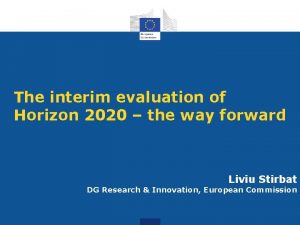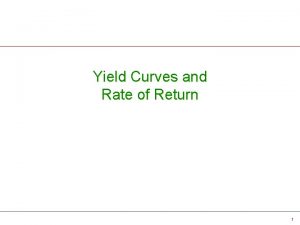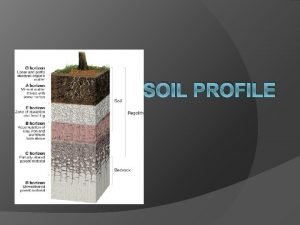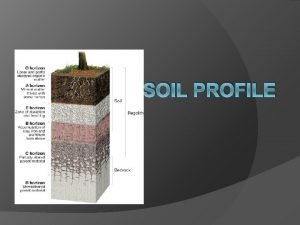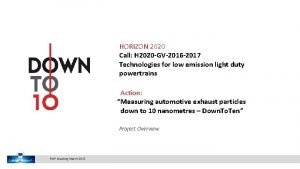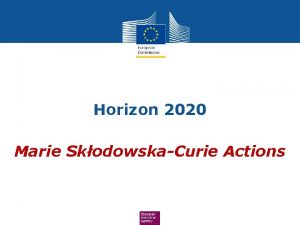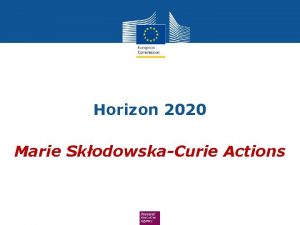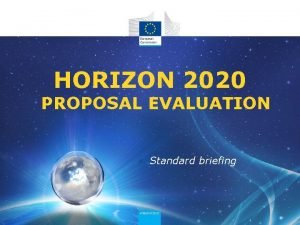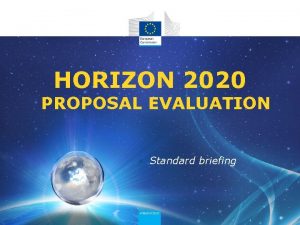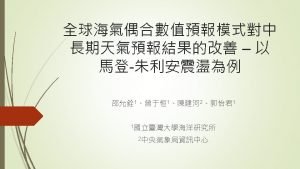HORIZON 2020 Call H 2020 GV2016 2017 Technologies




















- Slides: 20

HORIZON 2020 Call: H 2020 -GV-2016 -2017 Technologies for low emission light duty powertrains Action: “Measuring automotive exhaust particles down to 10 nanometres – Down. To. Ten” Jon Andersson, Ricardo 51 st PMP Meeting, 29 October 2019, Brussels

Exhaust aerosol is not all ‘solid’ Tailpipe (ms to s) … These are regulated Roadside (s to min) … This mode tends to dominate roadside particle number Urban Environment (h) This part is not regulated, but affects AQ more than regulatory PN 2

Overall concept & approach 1. Develop instrumentation and optimal sampling set-up to measure exhaust particles as small as 10 nm 3. Use new setup to measure latest vehicle technologies (collaboration with parallel H 2020 projects) 2. Develop models to understand particle transformation from the tailpipe to sampling and then to the atmosphere 4. Synthesize results to provide policy recommendations incl. metrology (WP 5) 3

DTT: Selected High-level Aspects • PN system to optimise sampling and transport of <23 nm to the counting element, and calibrate – to be nominally compliant with PMP system, to aid rapid adoption into current PMPbased legislation – to enable exploration of “total particles” emissions (e. g. by removal of the catalytic stripper) and apply to secondary particle production • Exploration of chemistry of sub-23 nm PN and total particles using novel analytical approaches (including prompt gamma activation analysis and mass spectrometry) • To explore and identify the presence of substantial <23 nm PN from current and future vehicle, and engine, technologies 4

DTT 3 rd GEN: (2019) DTT PEPS: Down. To. Ten Portable Exhaust Particle Sampling Based upon prior lab-system design On-board capability Dimensions: 50 x 50 cm 2 CPCs: 10 nm, 23 nm ~ 100 W required heating power Optimized Catalytic Stripper Battery pack for energy supply Pressurized bottle for dilution air Dedicated software Inlet Catalytic Stripper Porous Tu be Dilutor Cooling spiral • • Dilution Air Heater CPC 1 Pump 2 Pump 1 5

1 st Dilute Heater r & CS PEPS Laboratory Installation Heated Inlet 2 nd Diluter • CPC In addition to CVS installation, the DTT sampling system can be used for sampling raw exhaust 6

PEPS On-Board Installation CPC 23 eti nth Sy CPC 10 line He e ate d l ott ir b ca 7

Technologies characterization and the relevance of SPN<23

Majority of Tests below 6× 1011 km-1 for SPN<23 AND SPN>23. But… A few results demonstrate emissions levels of PN⑩ up to ~10 x the current limit value, with these tests also exceeding the limit value for the PN 23 range 6 x 1011#/km Zoom In… 9

Discrete discontinuous events, esp. cold start, result in high emissions • • • Short-term events (~100 s) compared to Euro 6 limit value – Cold start would not be regulated in isolation! Applications with highest emissions tend to be SI, even with GPF – Indicative of cold-start PN challenge with SI applications Some diesels are marginally over the “limit” – Likely to be immediately postregneration 10

You can find SPN<23 from DPF Diesels… those birthed by the fires of regeneration… PM filter collected for chemical analysis of <23 nm PN [TUM] PGAA indicated probable presence of lubricant metals in regeneration • There is a <23 nm particle production event that takes place a few minutes after post-injection starts. This leads to emissions of <23 nm particles at levels 10 to 100 x times those seen in the >23 nm range for a period of 2 -3 minutes • These particles are not numerous enough to influence a pass or fail result at the Euro 6 c PN limit once the Ki factor is included 11

“Artefact” SPN<23 particles can be produced in a chassis dyno test facility under extreme conditions • ARTEFACT – High temperature artefact identified while using GDI engine at extreme conditions: exhaust temperature post 4 WC at ~950°C – 100 x increase in SPN>4 – Substantially greater impact than on SPN>10, and limited impact on SPN>23 range – Believed to be transfer line artefact – Outside the range of any regulatory cycle: high v*a_pos and full load – RAW lab measurements would avoid this possibility 12

Recently completed vehicle tests Note: Not all vehicles measured with latest DTT system 13

SPN>23 nm emission levels • • Since the introduction of DPFs (Euro 5), diesel SPN>23 nm is the lowest of all vehicle types Gasoline EU 6 technology vehicles: – – • • Emit at or above the limit when equipped with DI engines, hence GPF will be required May also emit above the limit when equipped with PFI engines, current regulations only address PN from DI For older gasoline vehicles (LPG retrofitted ones), very high SPN>23 nm despite PFI operation OEM LPG and CNG lead to lower SPN>23 nm than gasoline (down to DPF-like levels) 14

SPN<23 nm emission levels • SPN<23 emissions should not be neglected ↑<5 x • High SPN<23/SPN>23 and especially 2. 5/23 nm ratios are observed in some cases of GDI and CNG engines ↑>30 x • Low ratios are observed in diesel vehicles 15

SPN-related conclusions • • For research, SPN<23 nm measurement on the road is possible Indications from globally-relevant drive cycles, on both SI and CI applications, are that SPN <23 increases relative to SPN>23 mostly by 20 -60% on average. Most results remain below 6× 1011 km-1. There are discontinuous events for diesel vehicles that lead to short-term increases in PN ⑩. These increases (>10×) have moderate drive cycle impacts; highest emissions observed were ~4× the limit. Order of PN<23 / PN>23 ratio (from high to low): – – • • 100×: A single gas-injection CNG and Diesel+DPF Regenerating 1. 5 -20×: GDI w/o GPF 1 -5×: GDI w. GPF 1 -1. 5×: Diesel + DPF (non-regenerating) Decreasing the threshold below 23 nm may be proven crucial for some vehicle technologies Potential SPN<23 measurement artefacts, suggests that under the most extreme operation the DTT PEPS results are only comparable with a raw exhaust lab-based measurement system, rather than the CVS – Implications for standardization/regulation 16

Collaboration with H 2020 projects Vehicle testing with DTT PEPS at Ricardo • GPF testing at LAT • Vehicle anticipated for testing with DTT PEPS • Vehicle tested with DTT PEPS at JRC 17

Final steps • Tests still go on with emphasis: – – Hybrids and plug-in hybrids Cold-start GPF Chemical characterisation of nanoparticles using various Mass Specs Semi-volatile and secondary particle formation characterisation 18

19

Consortium In collaboration with: The University of California at Riverside, Tokyo Denki University(Japan) and National Metrology Institute (Japan) 20
 Horizon 2020 participant portal
Horizon 2020 participant portal Horizon 2020 2021
Horizon 2020 2021 Horizon 2020 smart cities
Horizon 2020 smart cities Horizon 2020
Horizon 2020 Horizon results platform
Horizon results platform Protective put payoff
Protective put payoff What is options
What is options Gartner magic quadrant call recording
Gartner magic quadrant call recording Horizon yield
Horizon yield Po box 24080 newark nj 07101
Po box 24080 newark nj 07101 Horizon nj health eft enrollment
Horizon nj health eft enrollment Soil profile is a vertical cross section
Soil profile is a vertical cross section Food web soil profile
Food web soil profile Retention and drainage
Retention and drainage Soil profile diagram
Soil profile diagram E horizon
E horizon Soil
Soil O a e b c r
O a e b c r Regolith
Regolith Horizon
Horizon Lost horizon meaning
Lost horizon meaning



